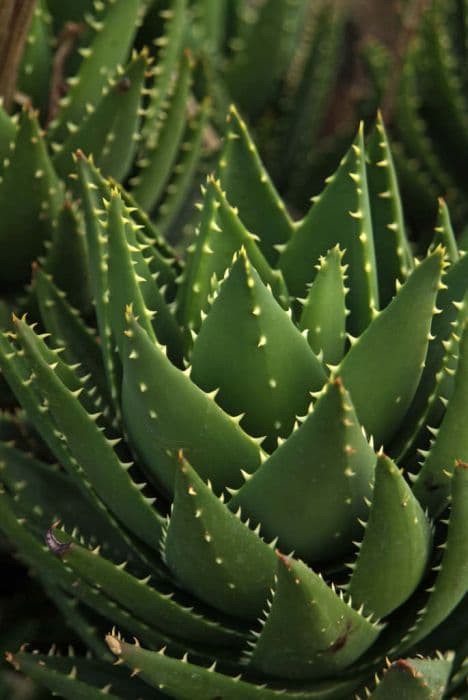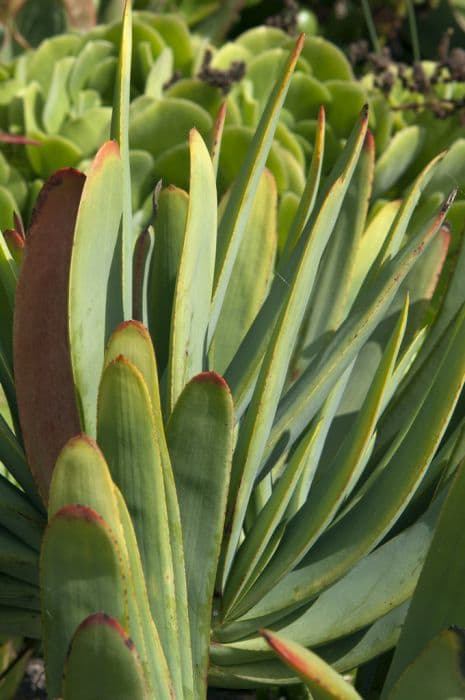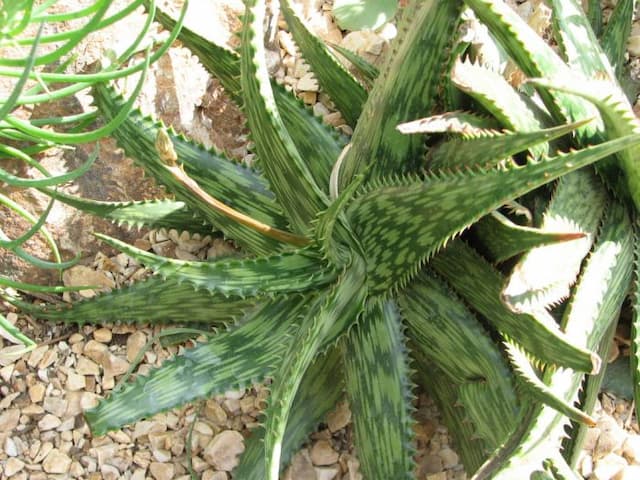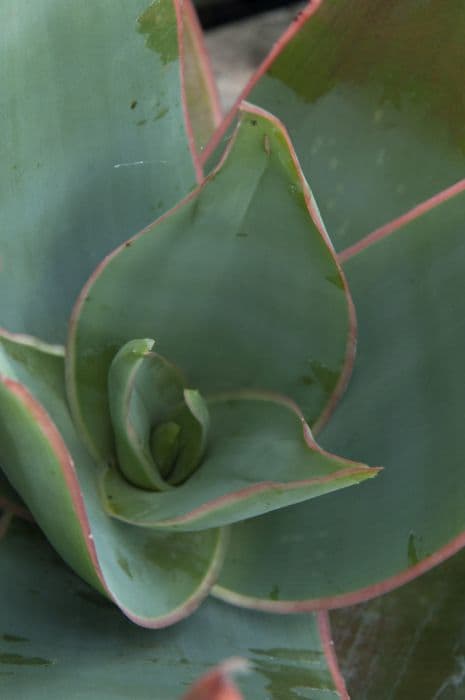Red Hot Poker Kniphofia × erecta

ABOUT
The plant known most commonly as Red Hot Poker or Torch Lily features a bold and striking appearance. It is characterized by its vibrant flower spikes that range in color from red to orange and sometimes fading to yellow at the bottom, reminiscent of a flaming torch. These flower spikes are composed of tubular, densely clustered blossoms that sit atop a sturdy, upright stem, giving the plant a very erect and proud posture. The foliage below the blossoms forms a basal clump of long, strap-like leaves that are pointy at the ends, and they present a rich green color, which contrasts nicely with the fiery hues of the flowers. The leaves are somewhat arching, emerging from the base of the plant and creating a grassy appearance. The flowers are known to attract a variety of pollinators including hummingbirds, bees, and butterflies, making it a lively addition to any garden. The plant's blossoms are not only visually stimulating but also have a certain architectural quality, adding vertical interest to landscape designs. Throughout its flowering season, the plant maintains its visual appeal with the flower spikes gradually releasing their colors, enhancing the garden scape with a prolonged display of warm tones.
About this plant
 Names
NamesFamily
Asphodelaceae
Synonyms
Red Hot Poker, Torch Lily, Tritoma
Common names
Kniphofia × erecta
 Toxicity
ToxicityTo humans
Red hot poker (Kniphofia × erecta) is not generally considered toxic to humans. There is no widespread documentation of poisoning or serious adverse effects from ingesting parts of this plant. However, it is always advisable to avoid eating ornamental plants due to potential individual sensitivities or the presence of harmful substances not typically present in food plants.
To pets
Red hot poker (Kniphofia × erecta) is also not generally recognized as toxic to pets. There is a lack of significant reports regarding illness in animals after ingesting this plant. Nonetheless, as with humans, it is prudent to prevent pets from consuming ornamental plants to avoid potential individual reactions or digestive issues.
 Characteristics
CharacteristicsLife cycle
Perennials
Foliage type
Evergreen
Color of leaves
Green
Flower color
Mixed
Height
3 feet 0.91 meters
Spread
2 feet 0.61 meters
Plant type
Herb
Hardiness zones
6
Native area
South Africa
Benefits
 General Benefits
General Benefits- Attracts pollinators: Kniphofia × erecta, commonly known as Red Hot Poker, draws bees, butterflies, and hummingbirds to the garden, aiding in pollination.
- Drought tolerance: Once established, Red Hot Poker is resistant to periods of drought, making it suitable for water-wise gardens.
- Low maintenance: It requires minimal care once it is settled into the right growing conditions, making it a good choice for busy gardeners.
- Architectural interest: With its tall, striking flower spikes, Red Hot Poker adds vertical interest to garden beds and borders.
- Long blooming season: The Red Hot Poker has a lengthy blooming period, often lasting from early summer to late fall, providing sustained color in the landscape.
- Deer resistance: The plant is not a preferred choice for deer, which can help to prevent damage to the garden.
 Medical Properties
Medical Properties- This plant is not used for medical purposes.
 Air-purifying Qualities
Air-purifying QualitiesThis plant is not specifically known for air purifying qualities.
 Other Uses
Other Uses- Red Hot Poker is often used as a natural pest deterrent in gardens due to its strong scent and vibrant flowers, which can deter certain insects and animals.
- The nectar-rich blooms of the Red Hot Poker can be used to attract pollinators like bees, butterflies, and hummingbirds to the garden, aiding in the pollination of other plants.
- The striking appearance of the Red Hot Poker can be used in landscape design to create focal points or to add vertical interest in flower beds due to their tall flower spikes.
- The strong, reed-like foliage of the Red Hot Poker can be woven or used in crafts for making small baskets or decorative items when dried.
- The dried flowers of Red Hot Poker can be incorporated into floral arrangements, adding an exotic touch and lasting color to dried bouquets.
- Red Hot Poker can be planted in large outdoor pots where other plants struggle to thrive, providing a burst of color and texture on balconies or patios.
- The nectar of the Red Hot Poker can be used as a natural sweetener by carefully extracting it and using it in homemade syrups or as a sugar alternative.
- Gardeners sometimes use Red Hot Poker as a companion plant to vegetables, as its bright flowers can help in leading pests away from more vulnerable crops.
- Red Hot Poker can be used in educational gardens to teach about plant life cycles, pollination, and the importance of native flora and fauna interactions.
- The seed pods of Red Hot Poker, once dried, can be used in art and craft projects, especially by children, to create natural decorations or sculptures.
Interesting Facts
 Feng Shui
Feng ShuiThe Red Hot Poker is not used in Feng Shui practice.
 Zodiac Sign Compitability
Zodiac Sign CompitabilityThe Red Hot Poker is not used in astrology practice.
 Plant Symbolism
Plant Symbolism- Attention-grabbing: The Kniphofia × erecta, commonly known as Red Hot Poker, has bright, fiery blooms that demand attention, symbolizing a presence that cannot be ignored.
- Stand out: Its distinctive flower spikes stand out from the crowd, symbolizing uniqueness and the idea of standing out in life.
- Strength: The sturdy, upright nature of its stems signifies strength and resilience, able to withstand various conditions.
- Passion: With its hot-colored flowers, the Red Hot Poker represents deep passion and intense emotions.
- Courage: The bold and bright appearance of the plant is frequently associated with courage and boldness in facing life's challenges.
 Water
WaterThe Red Hot Poker (Kniphofia × erecta) should be watered deeply every week during its growing season, especially in dry or hot weather. Provide about 1 gallon of water per plant for each watering session to ensure the soil is thoroughly moistened. During winter or in cooler climates, reduce watering to every few weeks, allowing the soil to dry out somewhat between waterings. Avoid having standing water around the plant's base to prevent root rot.
 Light
LightThe Red Hot Poker thrives best in full sun conditions which means it requires at least 6 hours of direct sunlight daily. It is crucial to plant it in a spot where it can receive unfiltered sunlight throughout the day for optimal growth and flowering.
 Temperature
TemperatureThe Red Hot Poker is tolerant of a wide range of temperatures but grows best when the temperature is between 50°F and 85°F. It can survive minimum temperatures down to 10°F. To ensure healthy growth, avoid placing it in locations where the temperature could drop below this range for extended periods.
 Pruning
PruningPruning the Red Hot Poker should be done to remove spent flower stalks and to tidy up the plant by cutting away any dead leaves or foliage. Pruning is best done after flowering has ceased, typically in late summer or fall. This helps to encourage new growth and maintain an attractive plant.
 Cleaning
CleaningAs needed
 Soil
SoilRed Hot Poker plants thrive best in well-draining sandy or loamy soil with a pH range of 6.0 to 7.0. A mixture of two parts garden soil to one part coarse sand or perlite and one part compost or well-rotted manure provides a nutritious and well-aerated environment.
 Repotting
RepottingRed Hot Poker plants do not need to be repotted often, generally every 2-3 years or when the clump becomes overcrowded. It's best to repot in the spring or early summer.
 Humidity & Misting
Humidity & MistingRed Hot Poker plants are tolerant of a wide range of humidity levels but do well in moderate humidity. They do not have specific high humidity requirements and can thrive in the typical outdoor conditions where they are hardy.
 Suitable locations
Suitable locationsIndoor
Place in bright indirect light, avoid overwatering.
Outdoor
Plant in full sun, well-drained soil, and water moderately.
Hardiness zone
6-9 USDA
 Life cycle
Life cycleKniphofia × erecta, commonly known as Red Hot Poker, begins its life cycle as a seed, germinating in warm temperatures with sufficient moisture. The seedlings emerge and establish a rosette of strap-like leaves as they enter the vegetative growth stage. Over time, the plants develop a strong root system and increase their foliage mass. As they mature, typically in their second year, they start the reproductive phase by sending up tall flowering spikes with tubular flowers that range from red to orange or yellow, attracting pollinators such as hummingbirds and bees. After pollination, seeds are produced and dispersed, completing the cycle. During winter, the plant may die back and enter a period of dormancy, but with the arrival of warmer weather, it resumes growth from the rootstock.
 Propogation
PropogationPropogation time
Spring to Summer
The plant commonly known as Red Hot Poker (Kniphofia × erecta) is often propagated through division, a method which is particularly popular for this perennial. Division involves separating the clumps of mature plants into smaller segments that have a few leaves and a portion of the root system attached. This process is usually carried out in spring or early fall. To propagate by division, carefully lift the entire plant out of the ground with a spade or fork, ensuring minimal damage to the roots. The clump is then gently teased apart or cut with a sharp knife into smaller sections, each with at least one growth point. These divisions are then replanted at the same depth they were growing at originally, spaced adequately apart to allow room for growth. It's important to water the new divisions well after planting to help establish the root system.









